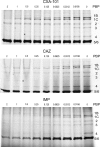Affinity of the new cephalosporin CXA-101 to penicillin-binding proteins of Pseudomonas aeruginosa
- PMID: 20547785
- PMCID: PMC2934984
- DOI: 10.1128/AAC.00296-10
Affinity of the new cephalosporin CXA-101 to penicillin-binding proteins of Pseudomonas aeruginosa
Abstract
CXA-101, previously designated FR264205, is a new antipseudomonal cephalosporin. The objective of this study was to determine the penicillin-binding protein (PBP) inhibition profile of CXA-101 compared to that of ceftazidime (PBP3 inhibitor) and imipenem (PBP2 inhibitor). Killing kinetics, the induction of AmpC expression, and associated changes on cell morphology were also investigated. The MICs for CXA-101, ceftazidime, and imipenem were 0.5, 1, and 1 microg/ml, respectively. Killing curves revealed that CXA-101 shows a concentration-independent bactericidal activity, with concentrations of 1x the MIC (0.5 microg/ml) producing a > 3-log reduction in bacterial load after 8 h of incubation. Live-dead staining showed that concentrations of CXA-101 as low as 0.5x the MIC stopped bacterial septation and induced an intense filamentation, which is consistent with the documented high affinity of PBP3. CXA-101 was found to be a potent PBP3 inhibitor and showed affinities > or = 2-fold higher than those of ceftazidime for all of the essential PBPs (1b, 1c, 2, and 3). Compared to imipenem, in addition to the obvious inverse PBP2/PBP3 affinities, CXA-101 showed a significantly higher affinity for PBP1b but a lower affinity for PBP1c. Furthermore, CXA-101, like ceftazidime and in contrast to imipenem, was found to be a very weak inducer of AmpC expression, consistent with the low PBP4 affinity documented.
Figures



Similar articles
-
Pan-β-lactam resistance development in Pseudomonas aeruginosa clinical strains: molecular mechanisms, penicillin-binding protein profiles, and binding affinities.Antimicrob Agents Chemother. 2012 Sep;56(9):4771-8. doi: 10.1128/AAC.00680-12. Epub 2012 Jun 25. Antimicrob Agents Chemother. 2012. PMID: 22733064 Free PMC article.
-
Activity of a new cephalosporin, CXA-101 (FR264205), against beta-lactam-resistant Pseudomonas aeruginosa mutants selected in vitro and after antipseudomonal treatment of intensive care unit patients.Antimicrob Agents Chemother. 2010 Mar;54(3):1213-7. doi: 10.1128/AAC.01104-09. Epub 2010 Jan 19. Antimicrob Agents Chemother. 2010. PMID: 20086158 Free PMC article.
-
Activity of cephalosporin CXA-101 (FR264205) against Pseudomonas aeruginosa and Burkholderia cepacia group strains and isolates.Int J Antimicrob Agents. 2009 Nov;34(5):402-6. doi: 10.1016/j.ijantimicag.2009.03.021. Epub 2009 May 9. Int J Antimicrob Agents. 2009. PMID: 19428220
-
Ceftolozane/Tazobactam: A Novel Cephalosporin/β-Lactamase Inhibitor Combination.Pharmacotherapy. 2015 Jul;35(7):701-15. doi: 10.1002/phar.1609. Epub 2015 Jul 1. Pharmacotherapy. 2015. PMID: 26133315 Review.
-
Cefiderocol: A Siderophore Cephalosporin with Activity Against Carbapenem-Resistant and Multidrug-Resistant Gram-Negative Bacilli.Drugs. 2019 Feb;79(3):271-289. doi: 10.1007/s40265-019-1055-2. Drugs. 2019. PMID: 30712199 Review.
Cited by
-
The "Old" and the "New" Antibiotics for MDR Gram-Negative Pathogens: For Whom, When, and How.Front Public Health. 2019 Jun 11;7:151. doi: 10.3389/fpubh.2019.00151. eCollection 2019. Front Public Health. 2019. PMID: 31245348 Free PMC article. Review.
-
Ceftolozane/tazobactam: a novel antipseudomonal cephalosporin and β-lactamase-inhibitor combination.Infect Drug Resist. 2013 Nov 29;6:215-23. doi: 10.2147/IDR.S36140. Infect Drug Resist. 2013. PMID: 24348053 Free PMC article. Review.
-
First Penicillin-Binding Protein Occupancy Patterns of β-Lactams and β-Lactamase Inhibitors in Klebsiella pneumoniae.Antimicrob Agents Chemother. 2018 May 25;62(6):e00282-18. doi: 10.1128/AAC.00282-18. Print 2018 Jun. Antimicrob Agents Chemother. 2018. PMID: 29712652 Free PMC article.
-
Population pharmacokinetics of ceftolozane/tazobactam in healthy volunteers, subjects with varying degrees of renal function and patients with bacterial infections.J Clin Pharmacol. 2015 Feb;55(2):230-9. doi: 10.1002/jcph.395. Epub 2014 Nov 14. J Clin Pharmacol. 2015. PMID: 25196976 Free PMC article. Clinical Trial.
-
What we may expect from novel antibacterial agents in the pipeline with respect to resistance and pharmacodynamic principles.J Pharmacokinet Pharmacodyn. 2017 Apr;44(2):113-132. doi: 10.1007/s10928-017-9506-4. Epub 2017 Feb 4. J Pharmacokinet Pharmacodyn. 2017. PMID: 28161807 Review.
References
-
- Blázquez, J., J. M. Gómez-Gómez, A. Oliver, C. Juan, V. Kapur, and V. Marin. 2006. PBP3 inhibition elicits adaptive responses in Pseudomonas aeruginosa. Mol. Microbiol. 62:84-99. - PubMed
-
- Curtis, N. A., D. Orr, G. W. Ross, and M. G. Boulton. 1979. Competition of beta-lactam antibiotics for the penicillin-binding proteins of Pseudomonas aeruginosa, Enterobacter cloacae, Klebsiella aerogenes, Proteus rettgeri, and Escherichia coli: comparison with antibacterial activity and effects upon bacterial morphology. Antimicrob. Agents Chemother. 16:325-328. - PMC - PubMed
Publication types
MeSH terms
Substances
LinkOut - more resources
Full Text Sources
Other Literature Sources
Medical
Research Materials
Miscellaneous

